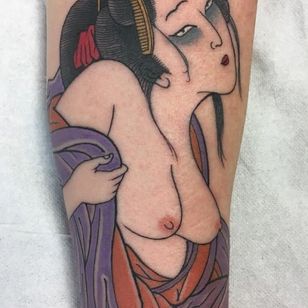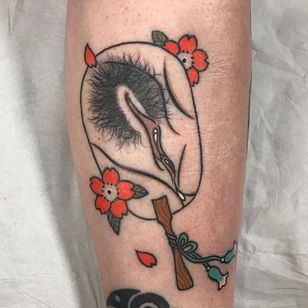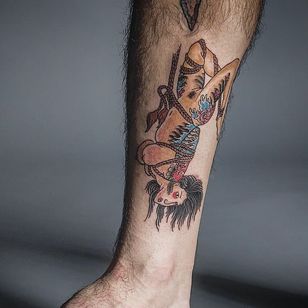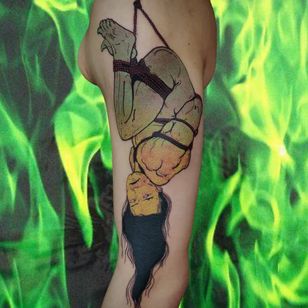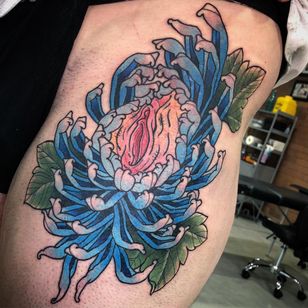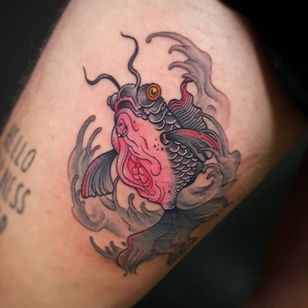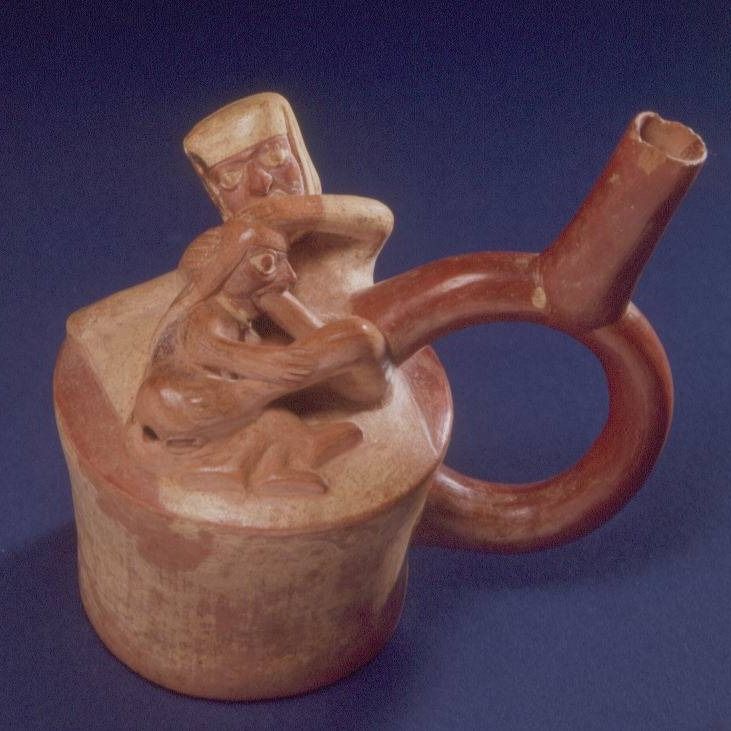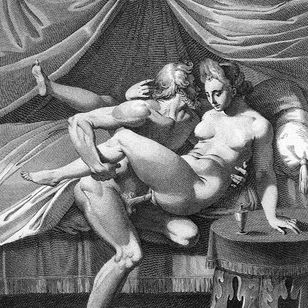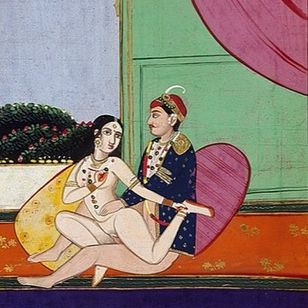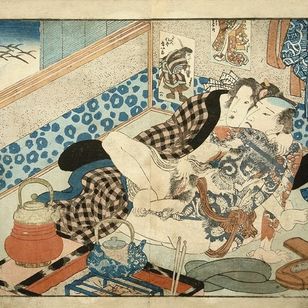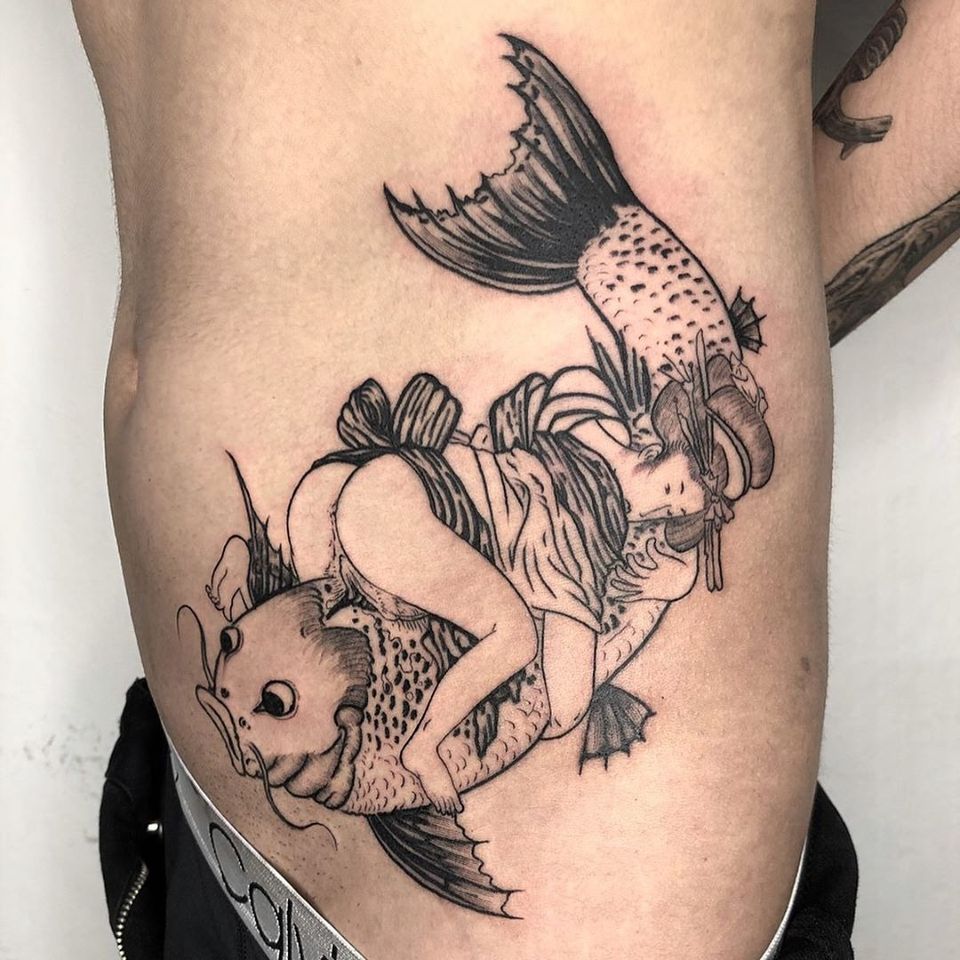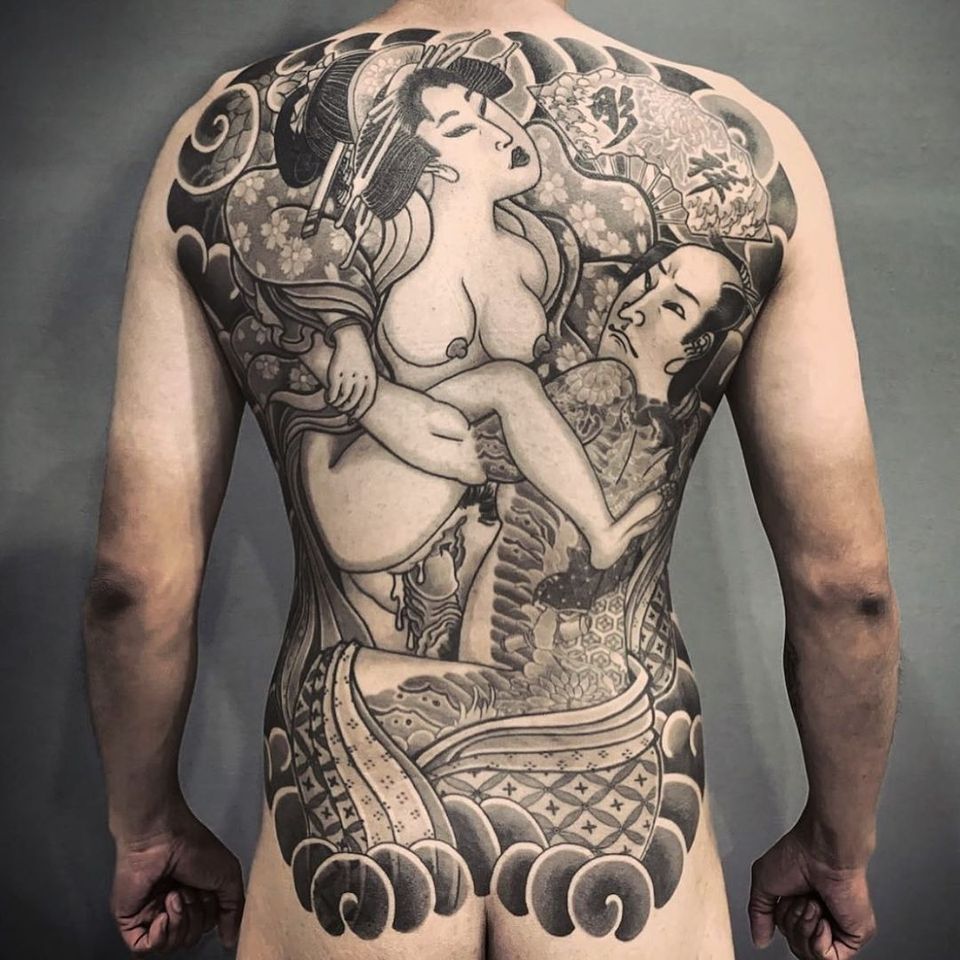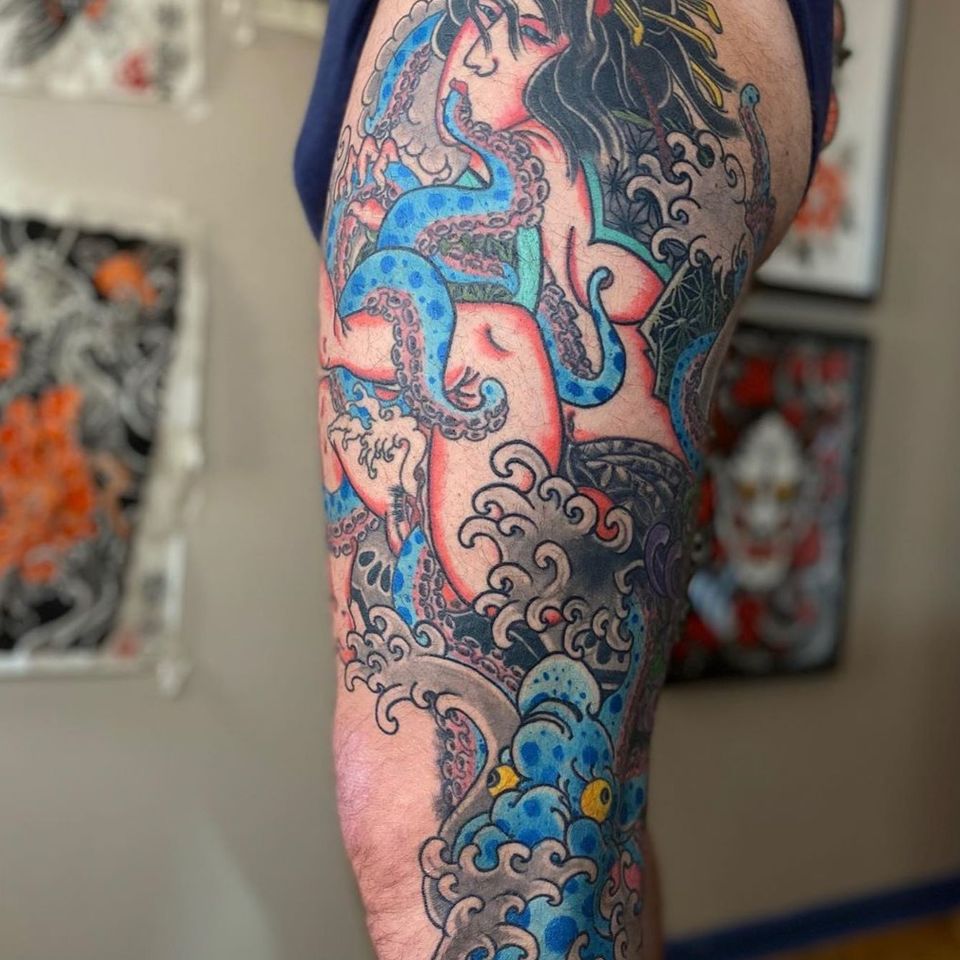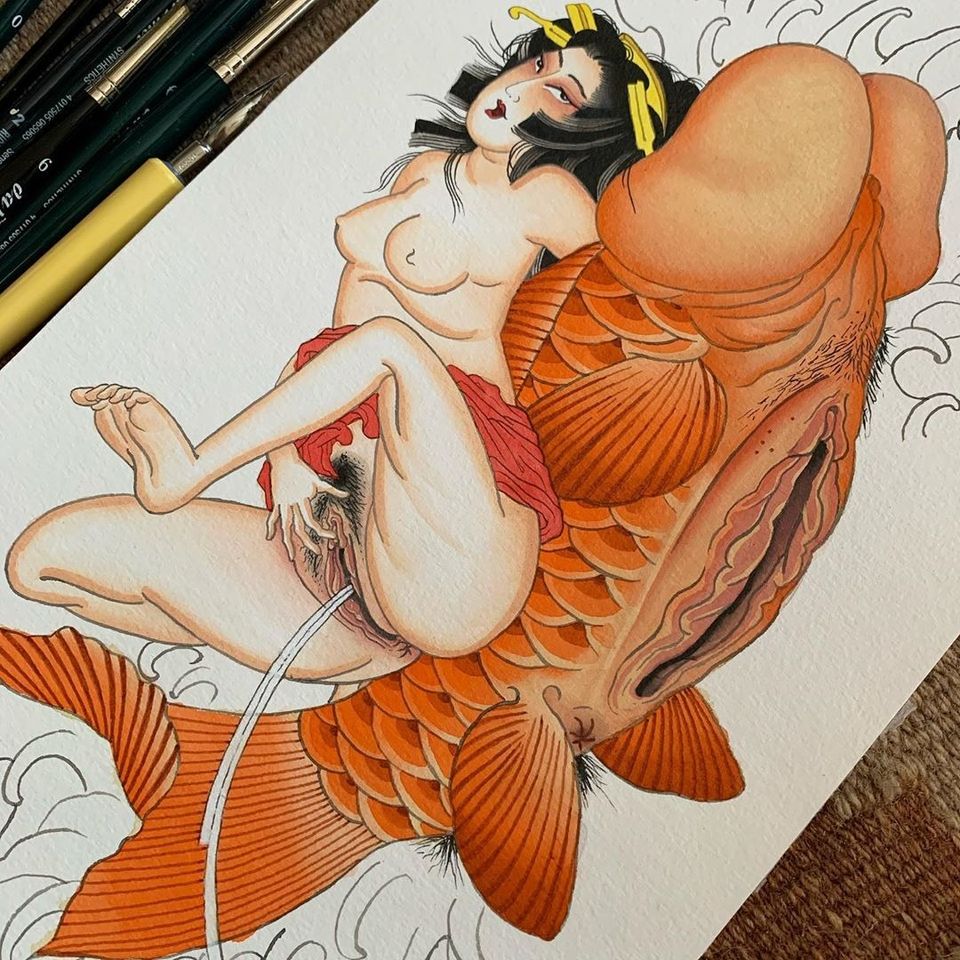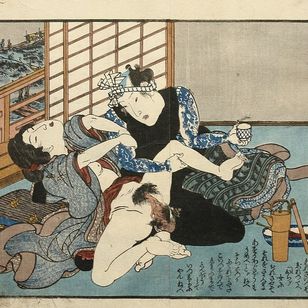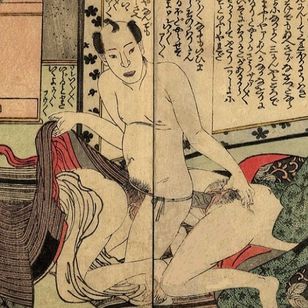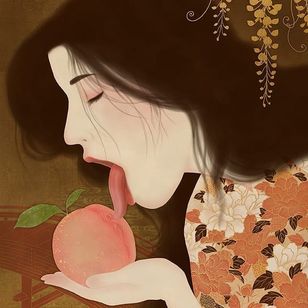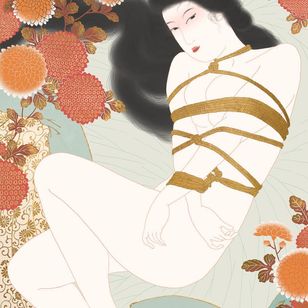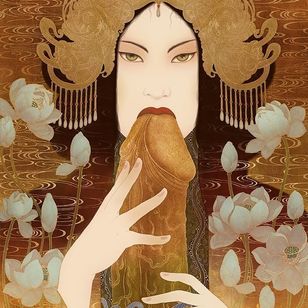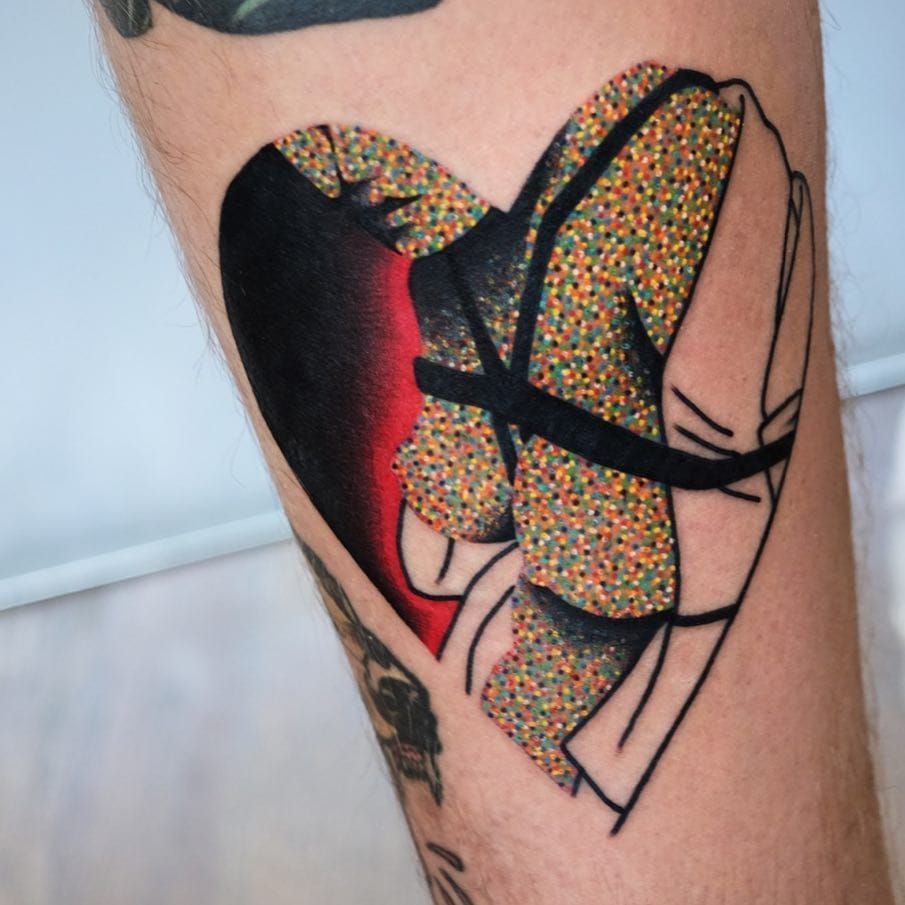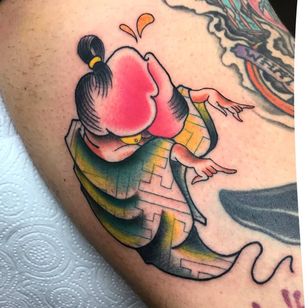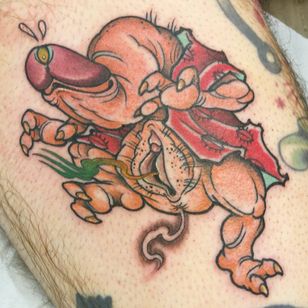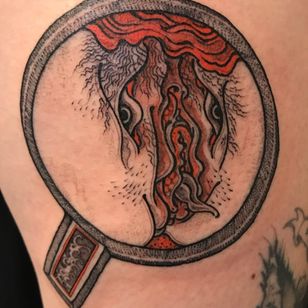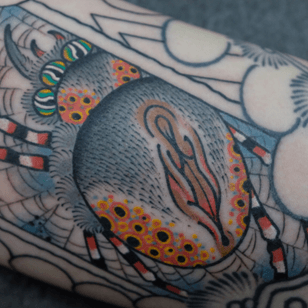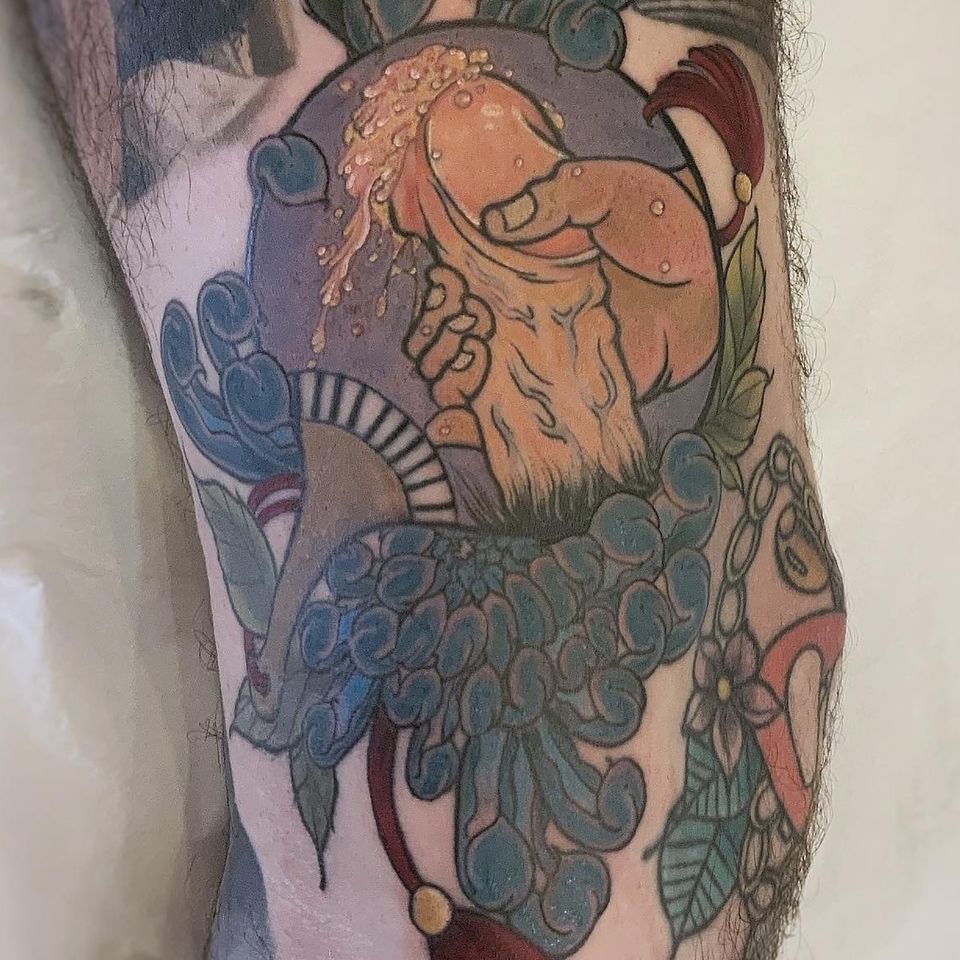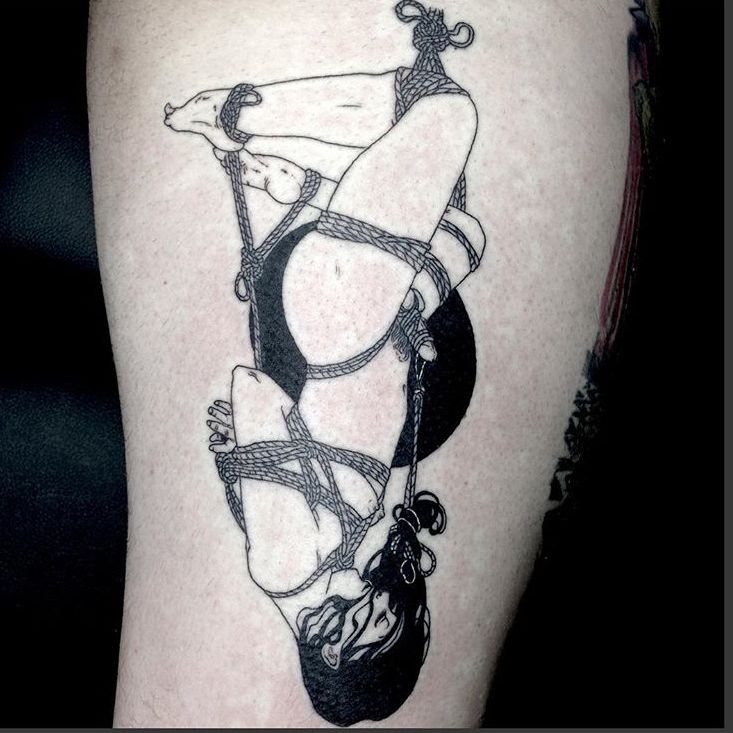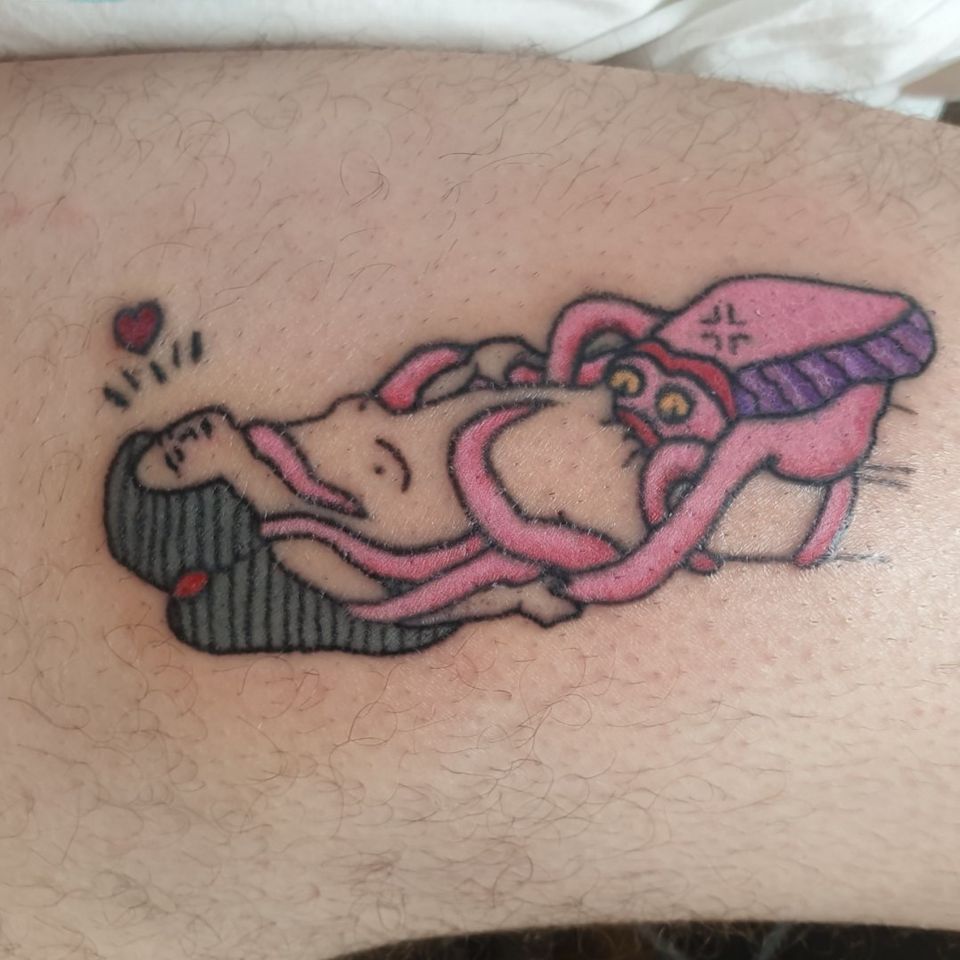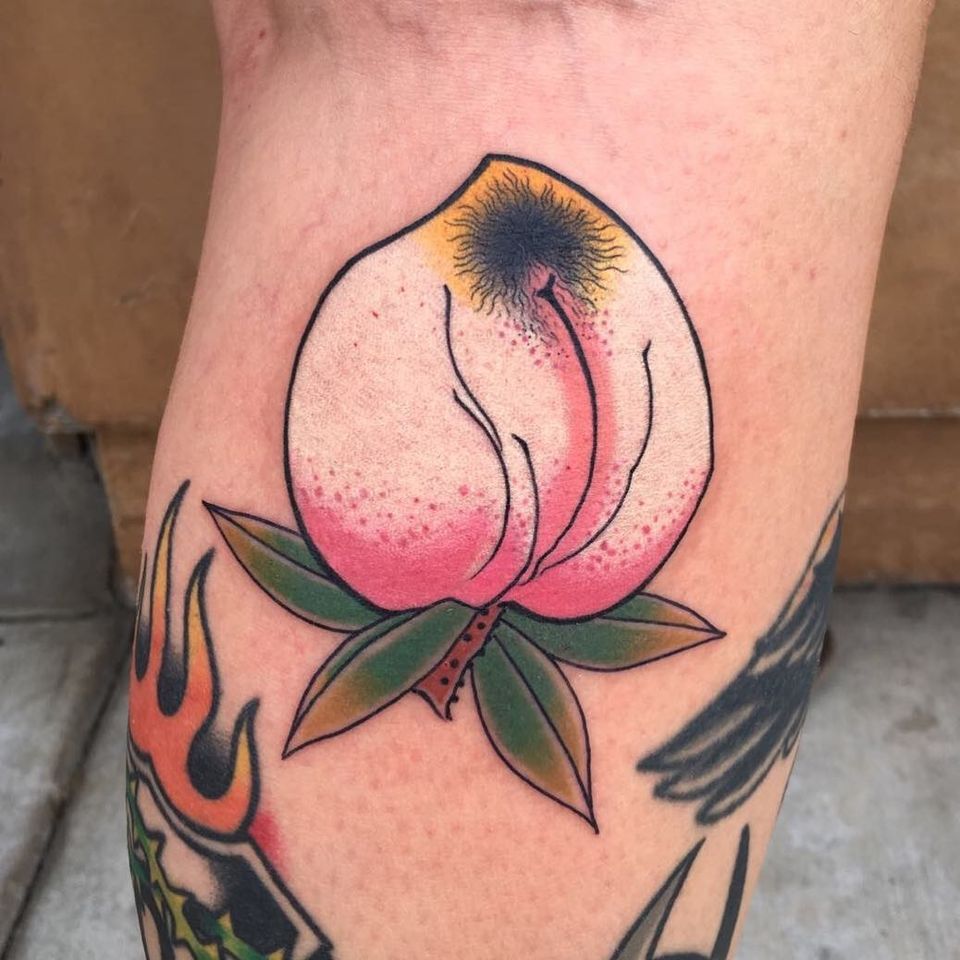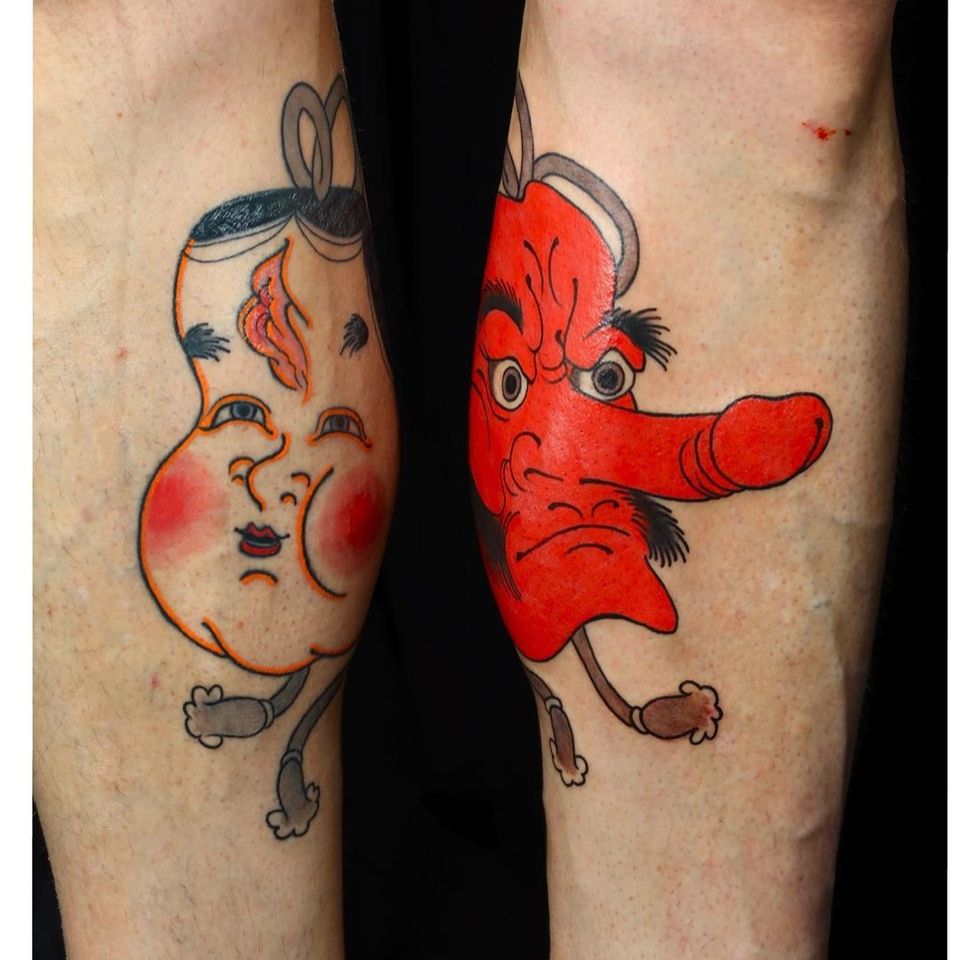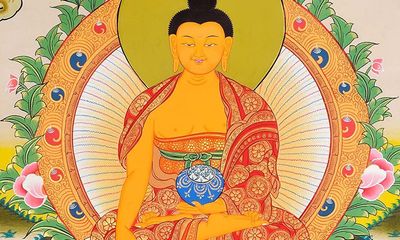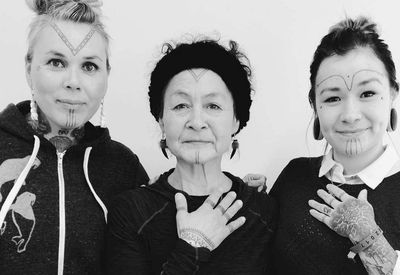NSFW: The Succulent Sexuality of Shunga Tattoos
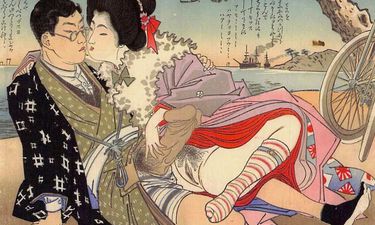
Summary
In this guide to Shunga tattoos, we talk about the history and inspiration behind some of the most fabulously kinky ink out there.
Smooth round lines, intricate kimono patterns, the unique approach to perspective...the aesthetics of Ukiyo-e have captured the attention of art lovers for decades. Even when the art movement began in the early 17th century, the popularity surged and artists were in high demand. And, hundreds of years later, Shunga tattoos would capture the deviant imaginations of millions.
The difference between Shunga and typical Ukiyo-e woodblock prints is not only the sex act...it’s the depiction of casualness and pure passion that, unless illustrating a warring samurai in action, may be missing from the static, calm prints seemingly most favored by the mainstream. Shunga captures a glimpse into an aspect of Japanese antiquity that is both fascinating and intoxicating.
Silks tossed upon the floor, veins pulsing with heightened blood flow, the visceral fervor felt through these captivating scenes is partly why this particular part of Japanese culture has inspired so many Shunga tattoos. In this article we dive into the history, cultural importance, controversy, and aesthetics of erotic tattoos inspired by Japanese pictures of the floating world.
The History of Shunga Tattoos and Japanese Erotica
Erotic tattoos may be somewhat new, however, humanity has always had the innate inclination to record the world around them, which of course would include the most natural thing in the world: human intercourse. The oldest figurative artwork ever found is the 44,000 year old cave painting in Sulawesi, a gorgeous Indonesian island east of Borneo. While that painting depicts hunters and their prey, other ancient art, such as the famed Paleolithic Venus figurines, have been connected to fertility, sex, and the cycle of life.
The Venus of Hohle Fels is the oldest depiction of a woman, aged at about 35,000 years, and has been described by an anthropologist as “by modern standards...“could be seen as bordering on the pornographic.” The breasts are burgeoning from the body, and the vulva has been sculpted with an exaggerated size, much like other Venus figurines that have been found. It is an obvious and powerful emblem of fecundity and sex which has also inspired many erotic tattoo designs.
Since humans have always been a bit obsessed with intercourse, it’s no wonder that in later years cultures around the globe have produced their own stylistic representations of physical intimacy that have spawned imagery like Shunga tattoos. Both the Romans and Greeks are known for their stunning frescoes depicting everything from orgies to bestiality. The ancient Andean Moche people, present from 100-700 AD in Peru, are praised for their “sex pots”, terra cotta colored vessels created by artists who seemed particularly interested in anal.
What was to really change the game for erotica was the invention of the printing press in 1440 by Johannes Gutenberg in Germany. Imagery was now not only easily replicated but easily dispersed to a wider audience with a large appetite for the strange and sensual. Cultures across the globe developed their own printing techniques and artistic aesthetics to portray one of their favorite pastimes, including the Japanese who created visual eroticism that was to inspire a bevy of Shunga tattoos.
The Edo period lasted from about 1603 to 1868, the art of which inspired famed painters like Van Gogh and Monet. The particular visuals of woodblock prints and paintings from this era were also used within Shunga; bursts of color, pattern, and line. It is said that the erotica was influenced both by Chinese medicinal manual illustrations as well as Chinese painter Zhou Fang. It’s also worth noting that almost every Japanese artist producing work during the Edo period made Shunga at one point or another, even the famed painter Hokusai, creator of “The Great Wave off Kanagawa.”
Shunga tattoo by Alina Vives #AlinaVives #shungatattoo #shunga #erotictattoo #erotic #nsfw #japanesetattoo #japaneseinspired
In 1661 the Tokugawa shogunate tried to suppress the creation of Shunga paintings and books, known as kōshokubon, the attempts were futile. Later, between 1790 and 1843, the Kansei, Khoyo, and Tenpō Reforms also tried to suppress the outpouring of erotic imagery but, again, with little success. Thankfully, artists continued to create and reproduce these works of visionary eroticism for freak flag flyers who seek out Shunga tattoos.
These ancient erotic works not only inspired Shunga tattoos, but important aspects of Japanese culture like Eru-Guro and Hentai, the sexy sister of anime. Both Ero-Guro and Hentai have influenced tattoo artists who are looking for a more contemporary take on antique Shunga. Ero-Guro, in particular, has a much more dark and violent flavour than that of the playful, lavish floating world. All of these, however, have sparked interest in contemporary tattoo clients and artists.
Shunga tattoo by crissinrostro #crissinrostro #shungatattoo #shunga #erotictattoo #erotic #nsfw #japanesetattoo #japaneseinspired
Visual Elements of Shunga Tattoos
Perhaps the most visually striking aspect of Shunga, and the Shunga tattoos inspired by the movement, are the larger than life phalluses. Historian Rachael Redjou explains, “This phenomenon of exaggerated male genitalia is thought to have originated from “kachi-e”. Also known as “victory pictures” or “pictures of contests”...art historians use “kachi-e” to refer to medieval hand scrolls that contained images of “phallic contests”. In these contests, men with penises perhaps half the size of their body were measured and seen performing amazing feats with their genitals.” Many erotic tattoos have actually focused completely on this motif alone.
Shunga tattoo by diaoshane #diaoshane #shungatattoo #shunga #erotictattoo #erotic #nsfw #japanesetattoo #japaneseinspired
Though the enlarged penises may be the first thing to catch your eye, the second will hopefully be the amount of pleasure and happiness usually captured within these images. The beauty of this isn’t only, obviously, people having a good time, but through a contemporary lens, imbues these antique erotic creations with a sense of sexual liberation and equality for all sexes involved.
Shunga tattoo by Rion #Rion #shungatattoo #shunga #erotictattoo #erotic #nsfw #japanesetattoo #japaneseinspired
The people depicted within Shunga are actually from a diverse group: different ages, sexual orientation, professions, and background are beautifully represented through details within the finished pieces. This narrative, considering the times, is inherently empowering. Considering, as well, that Shunga translated means “spring”, these images are a direct celebration of virility, sexual glee, and passionate joy shared with another.
Shunga tattoo by airakay ink #airakayink #shungatattoo #shunga #erotictattoo #erotic #nsfw #japanesetattoo #japaneseinspired
There is also a dreamlike or surreal quality inherent in some Shunga tattoos or prints. It’s not only giant genitalia, it’s also folkloric aspects that kind find themselves creeping into this art movement. Perhaps the best example is “The Dream of the Fisherman’s Wife” by Hokusai. Depicting an octopus performing cunnilingus on a reclining nude woman, this particular piece is one of the most famous examples of not only Shunga, but the Japanese fetish for tentacles usually referred to as tentai. Who wouldn’t want their lover to have more arms than just the usual two?
Shunga tattoo by Horikenshin #Horikenshin #shungatattoo #shunga #erotictattoo #erotic #nsfw #japanesetattoo #japaneseinspired
While the sex act in the foreground of these images can be totally distracting, in the best kind of way, make sure to check out the background as well. Details like lounging cats, lovely landscapes, and even peeping toms, may be seen within Shunga, but even more fun: you may also notice sex toys here and there pop up for play time.
Shunga tattoo by Sara Ruiz #SaraRuiz #shungatattoo #shunga #erotictattoo #erotic #nsfw #japanesetattoo #japaneseinspired
Anal beads, cock rings, dildos, lubricants….you name it. Often these novelty trifles came in a box set, an example of which can be seen below. If the Ukiyo-e prints themselves aren’t enough inspiration for your Shunga tattoo, perhaps look at the details and you’ll be surprised what you and your artist can come up with for your design!
Important Shunga Tattoo Artists
Perhaps the most influential of all Ukiyo-e artists is Hokusai, who may be known for illustrating Mount Fuji but also penned and painted illustrations for his book, “Gods of Intercourse.” Hokusai was a master at these prints and produced some of the most famous examples of Shunga such as “The Dream of the Fisherman’s Wife” mentioned above. Many Shunga tattoos directly reimagine or reproduce his works.
Shunga art by Alina Vives #AlinaVives #shungatattoo #shunga #erotictattoo #erotic #nsfw #japanesetattoo #japaneseinspired
Another artist well known for his contribution to Shunga is Kitagawa Utamaro who created “Lovers in an Upstairs Room”, a work that is perhaps one of the most revered masterpieces within this movement. There are many reasons for that, but the pattern work and kimono placement seamlessly moves the viewer's eye around the image but even further, the intimacy between the two individuals is palpable. A slight hidden detail is that the man's eye stares out at the observer, making the experience even more voyeuristic.
Other artists of note are Utagawa Kunisada, Kuniyoshi, Shigenobu, Keishu Takeuchi, Keisai Eisen, and Kawanabe Kyosai. Again, many artists of the Ukiyo-e period created Shunga at one time or another so the list of artists is massive and varies greatly depending on personal style and concentration.
Shunga art by Rion #Rion #shungatattoo #shunga #erotictattoo #erotic #nsfw #japanesetattoo #japaneseinspired
One contemporary artist of note who focuses completely on Shunga is Senju, a former tattooist himself, his erotic works are often reproduced in tattoo form.
Shunga Tattoo Controversy
Of course, as with all kinky or taboo topics, Shunga tattoos have received some criticism from outsiders who are unaware of the kind of sexual liberation and empowerment these images represent. However, behind this, like Irezumi in general, Shunga tattoos have been pointed at as examples of appropriation if someone who is not Japanese adorns their body with this imagery.
The Empress - tattoo by - #shungatattoo #shunga #erotictattoo #erotic #nsfw #japanesetattoo #japaneseinspired
However, it’s important to recognize that Japanese tattoos have long held a stigma. Historically, and even still today, Irezumi tattoos are thought of as specific to yakuza and other criminals regardless if Japan has finally ruled tattooing as not a medical act, and therefore no longer technically illegal. This means that, generally, Japanese people do not seek out tattoos from Japanese artists. There have been many tattoo techniques lost through the ages because they were targeted and repressed such as those of the Uchinanchu women in Okinawa. It’s incredibly important that Irezumi is preserved so that the art form doesn’t die out. This is partly why Japanese tattoo artists are willing to not only tattoo Western clients, but to share their knowledge with Western tattooers.
Araki tattoo by Cold Gray #ColdGray #blackandgrey #realism #realistic #hyperrealism #portrait #kimono #pattern #flowers #floral #shibari #Araki #cherryblossom #koi #fish #lady
It’s also important to recognize that Irezumi, as well as Shunga tattoos, typically do not use sacred symbology but rather iconography that comes from folklore, legends, or history. Unlike Maori tattoos or Buddha tattoos, which have fundamentally sacred, ritualistic, or religious connections, Japanese tattoos definitely have aspects of these elements but are not in and of themselves deeply sacrosanct. This is another great reason why it’s important to find a tattoo artist who truly knows and respects whatever design they happen to tattoo. It is also advisable to to get one of these tattoos fully comprehending the full philosophical, as well as aesthetic, background they represent.
Tattoo by Aleksy Marcinow #aleksymarcinow #kinkytattoos #kinktattoos #kink #kinky #bdsm #leather #fetish #queer #empower #love #consent #shibari #abstract #dotwork #popart #babe
Shunga tattoos are, to some, a fetishization of Asian women in the form of exploitative imagery. Due to the historical colonization of Asia by Western countries, as well as continued racism against Asian people, a sexually explicit tattoo can be seen as a symbol, and example, of that oppression and unhealthy power dynamic. Especially when sex is involved, a tattoo can take on many highly charged implications that the wearer may not have foreseen.
Shibari on knee done at Bordeaux France with love by Sad Amish #SadAmish #shungatattoo #shunga #erotictattoo #erotic #nsfw #japanesetattoo #japaneseinspired
It’s important with any tattoo to understand the risks of how people may perceive it, and to understand that someone may feel your erotic tattoo is hurtful. Keeping this in mind, make the most respectful choice for yourself and others.
Top Shunga Tattoo Artists
There are many tattoo artists who do Shunga tattoos or other erotic tattoos inspired by the Japanese arts. We've listed some below. But keep in mind, there are tons of tattooists out there who do beautiful Japanese and may never have been approached to do a Shunga tattoo. Find an artist you love, and ask them if they’d be willing...more often than not, they’ll definitely be down.
Jen Mogg has a lovely Illustrative style and uses many jewel tones that work incredibly well for Shunga tattoos. She truly captures the passion and romanticism of some antique Shunga prints.
Shunga tattoo by Jen Mogg #JennMogg - Uchiwa fan with shunga design and chrysanthemum. #shungatattoo #shunga #erotictattoo #erotic #nsfw #japanesetattoo #japaneseinspired #fan #chrysanthemum
Alina Bushman is one of our favorites who does kinky tattoos. Famed for perfectly capturing the subtle curves of cocks and kitties, Alina has an incredible output that Shunga fans will adore.

Gerald Feliciano is a tattooist who blends an adoration for Art Nouveau and Shunga in beautifully powerful ways. Read more about him and his creations via his interview.
Shibari tattoo by Gerald Feliciano #GeraldFeliciano #shibari #rope #bdsm #shungatattoo #shunga #erotictattoo #erotic #nsfw #japanesetattoo #japaneseinspired
Acetates has mastered blending modern kink culture with Ukiyo-e forms. He does a terrific leather daddy and plump pussy peaches ripe for the picking.
Shunga tattoo by Acetates #Acetates #shungatattoo #shunga #erotictattoo #erotic #nsfw #japanesetattoo #japaneseinspired
Rion has a fantastic humor that is reflected in her tattoos and artwork. Her Shunga tattoos beautifully capture the Ukiyo-e aesthetics while still adding her own personal vintage-esque touch.
Cute shunga peach tattoo by Rion #Rion #shungatattoo #shunga #erotictattoo #erotic #nsfw #japanesetattoo #japaneseinspired
Dansin has been known to whip out creepy but still kind of sexy Shunga pieces here and there. He also works with yokai quite often, so if you’re feeling like something a little less romantic, he’s a perfect fit.
Shunga tattoo by Dansin #Dansin #shungatattoo #shunga #erotictattoo #erotic #nsfw #japanesetattoo #japaneseinspired
Top Shunga Tattoo Motifs
Shibari Tattoo
Shibari tattoos depict the ancient art of Japanese rope bondage. Originating from Hojo-jutsu, a binding used for prisoners, many people have found Shibari to be deeply healing and sexually liberating.
Shibari girl with pink ropes done with love by Sad Amish #SadAmish #shungatattoo #shunga #erotictattoo #erotic #nsfw #japanesetattoo #japaneseinspired
The Dream of the Fisherman's Wife Tattoo
Not as popular as Hokusai’s wave, but almost, getting a Dream of the Fisherman's Wife tattoo recreates one of the best examples of Shunga out there. Truly a good one to show your kinkier side.
Dream of the Fishermans Wife #shunga #handpoke #handpoketattoo #handpoked #stickandpoke #sticknpoke #irezumiinspired #erotictattoo #octopustattoo #japanesetattoo
Pussy Peach Tattoo
Who doesn’t love these plush pussy peaches?! These are some of our favorites. There’s nothing cuter than a juicy pink peach with a sweet slice of snatch on the side. Whether created in yellow, white, purple, or orange tones...you literally can’t go wrong with one of these babies.
Pussy peach tattoo by Acetates #Acetates #shungatattoo #shunga #erotictattoo #erotic #nsfw #japanesetattoo #japaneseinspired
Pussy Snail Tattoo
Similar to pussy fish tattoos, pussy snail tattoos are super surreal and fun. They also make great fillers for small spaces.
Pussy snail tattoo by Aleksy Marcinow #aleksymarcinow #shungatattoo #shunga #erotictattoo #erotic #nsfw #japanesetattoo #japaneseinspired
Dick Fish Tattoo
Another hitter, pussy fish tattoos are not only sort of cute, but also super weird and definitely hilarious. If you ever see one of these lil guys swimming up the leg of some stranger, know they probably have a really great sense of humor.
Dick fish tattoo by orditattoo #orditattoo #shungatattoo #shunga #erotictattoo #erotic #nsfw #japanesetattoo #japaneseinspired
Tengu Dick Mask Tattoo
Tengu is an iconic character from Japanese folklore. He’s basically a red goblin with a human face, except he has a really really long nose that makes a perfect penis for Tengu dick mask tattoos.
Tengu dick mask tattoo by manekistefy_adrenalink #manekistefyadrenalink #shungatattoo #shunga #erotictattoo #erotic #nsfw #japanesetattoo #japaneseinspired
Shunga Yokai Tattoo
Yokai tattoos are some of the best out there because there’s just so many different types of them. They range from terrifying to cute to absolutely absurd, but slap a dick or vagina on one of these guys and you’ve got yourself an incredible Shunga yokai tattoo.
Shunga yokai tattoo by acetates #acetates #shungatattoo #shunga #erotictattoo #erotic #nsfw #japanesetattoo #japaneseinspired
Shunga Fan or Shunga Mirror Tattoo
For a Shunga mirror tattoo, just make sure that whatever is reflected in the mirror is something super sexy. Basically the idea behind these is that a woman is using a mirror to look at her own nether region. Few things are hotter than sexual curiosity and what we do when we’re alone with the right toys...
Shunga mirror tattoo by Sara ruiz #sararuiz #shungatattoo #shunga #erotictattoo #erotic #nsfw #japanesetattoo #japaneseinspired
